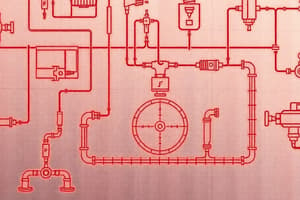Podcast
Questions and Answers
What is the primary function of pressure control valves?
What is the primary function of pressure control valves?
- To increase pressure in a system
- To monitor flow rates and provide feedback
- To reduce the amount of pressure in a tank or piping system (correct)
- To direct fluid flow in multiple pathways
Which type of valve is specifically designed to ensure fluid flows in one direction only?
Which type of valve is specifically designed to ensure fluid flows in one direction only?
- Check valves (correct)
- Directional valves
- Pressure control valves
- Flow control valves
How many positions does a standard 2-way directional valve have?
How many positions does a standard 2-way directional valve have?
- Two (correct)
- One
- Three
- Four
What type of valve is used to control the amount of fluid flow in a system?
What type of valve is used to control the amount of fluid flow in a system?
Which control mechanism is NOT typically associated with directional valves?
Which control mechanism is NOT typically associated with directional valves?
In terms of positions, how many does a 4-way directional valve have?
In terms of positions, how many does a 4-way directional valve have?
Which control method utilizes electrical signals to operate valves?
Which control method utilizes electrical signals to operate valves?
Which of these valves is used for controlling steps in a specific operational sequence?
Which of these valves is used for controlling steps in a specific operational sequence?
What principle does Pascal's law describe?
What principle does Pascal's law describe?
In which type of machinery is Pascal's law commonly applied?
In which type of machinery is Pascal's law commonly applied?
Which of the following is NOT a mobile hydraulic application?
Which of the following is NOT a mobile hydraulic application?
How is force multiplied in a hydraulic system according to Pascal's law?
How is force multiplied in a hydraulic system according to Pascal's law?
Which automotive component utilizes hydraulic principles?
Which automotive component utilizes hydraulic principles?
Which marine application primarily utilizes hydraulic technology?
Which marine application primarily utilizes hydraulic technology?
What is a typical use of hydraulic systems in aerospace equipment?
What is a typical use of hydraulic systems in aerospace equipment?
Which of the following best describes the function of hydraulic loaders?
Which of the following best describes the function of hydraulic loaders?
What is the primary function of a PLC?
What is the primary function of a PLC?
Which type of input switch allows current to flow when it is in the open position?
Which type of input switch allows current to flow when it is in the open position?
What is the first step in programming a PLC using ladder logic?
What is the first step in programming a PLC using ladder logic?
What is a common function that can be programmed into a PLC?
What is a common function that can be programmed into a PLC?
What type of devices are typically used to enter and modify PLC programs?
What type of devices are typically used to enter and modify PLC programs?
What role does the programmer have when developing PLC control solutions?
What role does the programmer have when developing PLC control solutions?
Which of the following is NOT one of the steps for programming a PLC?
Which of the following is NOT one of the steps for programming a PLC?
Which variable represents the buzzer in the PLC programming example?
Which variable represents the buzzer in the PLC programming example?
Flashcards
Control Valves
Control Valves
Valves used to regulate flow, pressure, and direction of fluid in systems.
Check Valves
Check Valves
Valves that allow fluid to flow in only one direction.
Pressure Control Valves
Pressure Control Valves
Valves used to adjust pressure in a system.
Flow Control Valves
Flow Control Valves
Signup and view all the flashcards
Directional Valves
Directional Valves
Signup and view all the flashcards
2-way valve
2-way valve
Signup and view all the flashcards
3-way valve
3-way valve
Signup and view all the flashcards
4-way valve
4-way valve
Signup and view all the flashcards
Pascal's Law
Pascal's Law
Signup and view all the flashcards
Hydraulic Press
Hydraulic Press
Signup and view all the flashcards
Force Multiplication
Force Multiplication
Signup and view all the flashcards
Hydraulic Systems
Hydraulic Systems
Signup and view all the flashcards
Industrial Applications
Industrial Applications
Signup and view all the flashcards
Mobile Hydraulics
Mobile Hydraulics
Signup and view all the flashcards
Automobile Applications
Automobile Applications
Signup and view all the flashcards
Area Ratio
Area Ratio
Signup and view all the flashcards
PLC (Programmable Logic Controller)
PLC (Programmable Logic Controller)
Signup and view all the flashcards
Input Switches (Normally Closed/Open)
Input Switches (Normally Closed/Open)
Signup and view all the flashcards
PLC Programming Software
PLC Programming Software
Signup and view all the flashcards
Ladder Logic
Ladder Logic
Signup and view all the flashcards
PLC Programming Steps (Step 1)
PLC Programming Steps (Step 1)
Signup and view all the flashcards
PLC Programming Steps(Step 2)
PLC Programming Steps(Step 2)
Signup and view all the flashcards
PLC Programming Steps(Step 3)
PLC Programming Steps(Step 3)
Signup and view all the flashcards
PLC Programming Devices
PLC Programming Devices
Signup and view all the flashcards
Study Notes
Hydraulics and Pneumatics
- Hydraulics is a technology using engineering, chemistry, and other sciences to work with liquid properties, specifically how liquids produce motion. Modern hydraulics uses confined liquid to transmit power, multiply force, and create motion.
- Pneumatic systems use compressed inert gases for power, often compressed air, to power cylinders, actuators, etc.
- Hydraulic systems use fluid (often oil) to perform work.
- Pascal's Law states that pressure applied to a confined fluid is transmitted equally in all directions with equal force on equal areas. This is fundamental to hydraulic systems using a smaller piston to generate a larger force on a larger piston.
Hydraulics and Pneumatics Component Systems
- Fluid: Oil for hydraulic systems, air for pneumatic systems.
- Reservoir: Storage tank for the fluid
- Hydraulic pump (compressor in pneumatics): Converts mechanical energy into hydraulic (or pneumatic) energy, forcing the fluid into the system.
- Fluid lines: Transport fluid through the system.
- Valves: Control pressure, direction, and flow rate of the fluid.
- Actuator: Converts hydraulic energy into mechanical energy for work.
Applications of Hydraulic Systems
- Industrial: Plastic processing, steel making, automated production lines, and more.
- Mobile: Tractors, irrigation systems, construction equipment.
- Automotive: Brakes, shocks, steering, etc.
- Marine: Vessels, fishing boats, and naval equipment.
- Aerospace: Aircraft control, landing gear, and other systems.
Control Valves
- Control valves regulate flow, pressure, and direction.
- Pressure control valves: Reduce pressure in systems or pipes.
- Flow control valves: Control the rate of fluid flow.
- Directional control valves: Control the direction of fluid flow.
Check Valves
- Allow fluid flow in one direction only.
Thermocouples
- Electrical devices made from dissimilar conductors which create a voltage that changes with temperature.
- Used for temperature sensing across a wide range of temperatures.
- Employ the Seebeck effect, where a voltage is produced whenever two dissimilar metals are joined together and a temperature difference exists between the junctions.
- Types of thermocouples: J, K, T, N, E, etc. each with specific properties (e.g., operating temperature range).
Transducers
- Often, electric or electronic devices that convert one form of energy to another.
- Many devices that collect data from sensors, measuring temperature, pressure, sound.
Studying That Suits You
Use AI to generate personalized quizzes and flashcards to suit your learning preferences.




